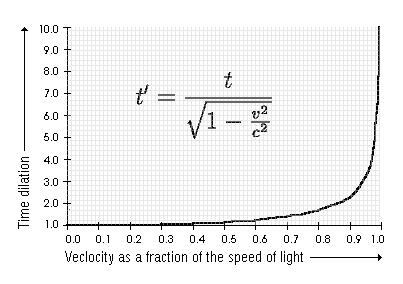time dilation

Time dilation is a phenomenon predicted by the special theory of relativity in which the passage of time in the frame of reference of a moving object slows down as the object approaches the speed of light. Effectively, this makes it possible to spend energy to buy time. Time dilation has been experimentally confirmed using cesium clocks that can measure extremely small periods of time.
A potentially important consequence follows for future interstellar flight. Simply by traveling fast enough, an astronaut can reach any destination within a specified amount of (shipboard) time. The table below gives the travel times, as measured by onboard clocks, to Arcturus, located 36 light-years (11 parsecs) from the Sun, for a spacecraft traveling at various speeds (given as fractions of the speed of light, c).
| Shipboard travel times to Arcturus at various speeds | |||||
|---|---|---|---|---|---|
| Speed | 0.1c | 0.5c | 0.9c | 0.99c | 0.999c |
| Travel time | 358.2 years | 62.4 years | 17.4 years | 5.13 years | 1.61 years |
This effect, however, also leads to a major drawback in exploiting time dilation to achieve long, crewed manned interstellar flight, namely that those who make the journey age less than those, including friends and family members, who remain behind. For very long journeys at high fractions of the speed of light, the time dislocation may be so great that many generations, and even millennia, may pass on the home planet before the interstellar travelers return. For example, an excursion from Earth to Rigel, 900 light-years away, and back, at (a constant) 99.99% of light-speed, would take 1,800 years as measured on Earth but only about 28 years as experienced by those on the spacecraft. It had been argued, for example by Sebastien von Hoerner, that such acute time dislocations – effectively hurling the travelers into the future – will prevent interstellar travel beyond a few tens of light-years and, therefore, the colonization of the Galaxy. However, there may be other ways to circumvent the light barrier.
Twins paradox
The twins paradox is a thought experiment in which one twin (A) travels into space at nearly the speed of light and returns to find he has aged less than his twin (B) who has remained on Earth. This result is paradoxical because of the seemingly symmetric roles played by A and B in the story. In fact, A returns younger than B because only A travels in a non-inertial (accelerating) reference frame. From B's point of view, A experiences time dilation, but from A's point of view the distance traveled is shortened because of length contraction.


